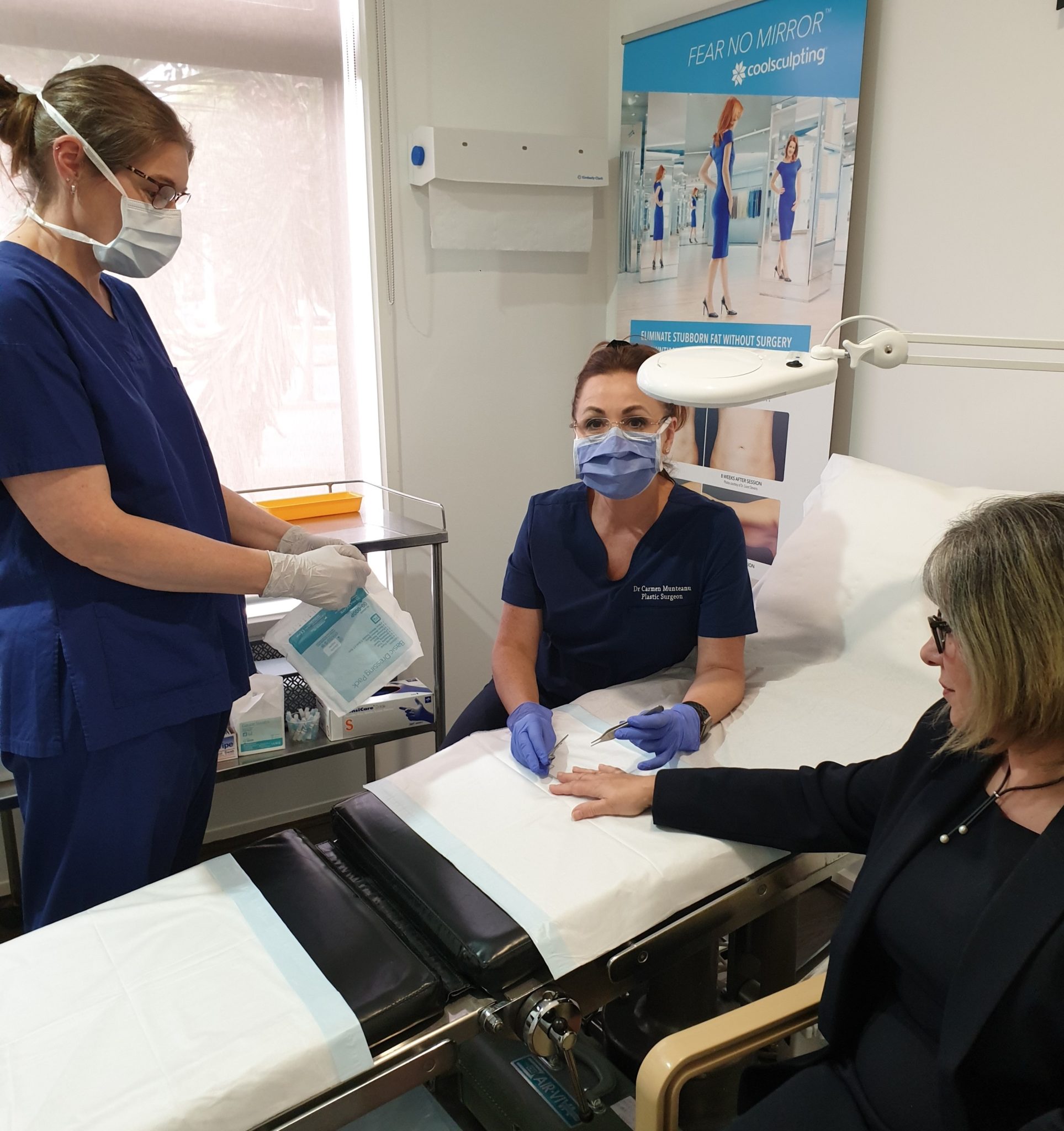Fat Transfer to Increase Breasts Size
Traditionally, breast implants have been the go-to solution for those looking to increase their breast size. However, in recent years, an alternative method has gained popularity – fat grafting to the breasts.
In this blog, Melbourne Specialist Plastic Surgeon Dr Carmen Munteanu will discuss the process of fat grafting and whether it can be used to augment the breasts instead of breast implants.
More about Fat Grafting
Also known as autologous fat transfer or breast lipofilling, this procedure involves harvesting fat from one part of the patient’s body – typically areas with excess fat like the abdomen, thighs, or hips – and injecting it into the breasts. This technique not only offers breast enlargement but also reshapes the donor area.
The Process of Fat Grafting
The procedure begins with liposuction to extract the fat. This fat is then purified and prepared for injection into the breasts. The process requires skill and precision, as the fat must be evenly distributed to achieve a natural look and feel.
Advantages of Fat Grafting
- Natural Look and Feel: One of the most significant advantages of fat grafting is the natural result it offers. Since it uses your own fat, the augmented breasts feel and move more naturally compared to synthetic implants
- Dual Benefit: This procedure not only increases breast size but also contours the donor area, offering a more comprehensive body reshaping solution
- Lower Risk of Rejection: As the fat used is from your own body, there is a significantly lower risk of rejection or allergic reactions compared to foreign materials like silicone or saline implants
- Minimal Scarring: Fat grafting requires only small incisions for the liposuction and injection process, leading to small scars
- Reduced Risk of Complications: Compared to implants, fat grafting has a lower risk of complications, and complications such as capsular contracture or implant rupture are avoided
Technological Advances in Fat Grafting
The field of fat grafting has seen significant technological advancements, enhancing both the safety and efficacy of the procedure.
- Improved Fat Purification and Injection Techniques: Modern techniques in fat processing have greatly improved the survival rate of transferred fat cells. The purification process is crucial – it involves separating the viable fat cells from the damaged ones and other fluids. Advanced centrifugation and filtration systems are now used to ensure that only the highest quality fat is reinjected
- Enhanced Fat Survival: The survival of fat cells post-transfer is a critical aspect of fat grafting. New techniques focus on ensuring the maximum survival of these cells. This includes gentle handling of the fat, minimal exposure to air, and precise, micro-droplet injection techniques. These methods ensure that the fat is evenly distributed and has a good blood supply, which is vital for cell survival
- Strategic Pre-Planning: Pre-planning is an essential part of the procedure with the use of phototherapy sessions before and after to optimise healthy cells. This combined with the consumption of essential amino acids post surgically is shown to aid cellular repair, improve blood flow, increase oxygen delivery and improve fat survival.
Fat Grafting – Limitations and Considerations
While fat grafting is a popular method for breast augmentation, offering a natural alternative to implants, it’s important to consider its limitations and implications thoroughly:
Limited Enhancement
- Modest Increase: Fat grafting is best suited for those seeking a moderate increase in breast size. Typically, it can enhance the breast by a maximum of one cup size in a single session. This is in contrast to implants, which can provide a more significant and immediate change in size
- Volume Limitations: There’s a limit to how much fat can be safely injected into the breasts at one time. Overfilling can compromise blood flow, leading to poor fat survival
Fat Absorption
- Variable Resorption Rates: A significant consideration in fat grafting is the unpredictability of fat absorption. In most cases, about 50-70% of the transferred fat survives, while the rest is reabsorbed by the body. This can lead to variations in breast size and shape over time
- Potential for Multiple Procedures: Due to this absorption, some patients may require multiple sessions to achieve their desired outcome, making it a potentially more prolonged process than implant surgery
Body Type Dependency
- Need for Adequate Donor Fat: The procedure is contingent on the patient having enough excess fat in other body areas. This makes it less suitable for individuals who are very lean or have a low body fat percentage
- Donor Site Considerations: The areas from which fat is harvested will also undergo changes. While this can be beneficial for contouring these areas, it may also lead to irregularities or asymmetry if not done carefully
Recovery Time
- Longer Downtime: The recovery period for fat grafting can be longer and possibly more uncomfortable compared to implants. This is because two areas of the body are healing simultaneously – the area where fat was harvested and the breasts. You might be given specific instructions to limit activities in order to increase fat take
- Post-Operative Care: You need to follow specific post-operative care instructions for both the donor and recipient sites, which may include wearing compression garments and avoiding pressure on the augmented breasts to ensure optimal fat graft survival
Additional Considerations
- Impact of Lifestyle and Weight Fluctuations: Future weight loss or gain can affect the results of fat grafting. Gained weight can lead to an increase in the size of the fat cells in the breasts, and conversely, weight loss can decrease their size
- Breast Screening: While fat grafting doesn’t impede mammograms, there can be changes in breast tissue, such as calcifications, that may require additional imaging or follow-up
Suitability and Expectations
- Individual Suitability: Not everyone is a suitable candidate for fat grafting. Factors such as overall health, breast structure, and skin quality play a significant role in determining if this procedure is appropriate
- Setting Realistic Expectations: It’s crucial for patients to have realistic expectations about the results of fat grafting. A thorough consultation with an experienced surgeon like Dr Carmen Munteanu is essential to understand what can and cannot be achieved with this procedure.
Fat Grafting vs Breast Implants
When deciding between fat grafting and breast implants, many factors come into play. Breast implants offer a more significant and predictable increase in size. They come in various shapes and sizes, allowing for a more tailored approach to breast augmentation. However, they also carry risks like implant rupture and capsular contracture and typically require replacement after a certain period.
On the other hand, fat grafting offers a more natural alternative with a lower risk of complications. The results are less predictable, and the degree of augmentation is generally more conservative. It’s essential to have realistic expectations and understand that the outcome can vary based on how the body absorbs the fat.
When considering breast augmentation, you should know that each method has its unique set of pros and cons, which can significantly impact the patient’s decision-making process.
Longevity and Maintenance
- Breast Implants: One of the critical considerations with breast implants is their longevity. Implants are not lifetime devices; they may require replacement after a period, usually around 10 to 15 years. Over time, implants can undergo changes like rupture or capsular contracture, necessitating revision surgery. Regular check-ups and MRI scans are recommended to monitor their condition
- Fat Grafting: In contrast, the results of fat grafting can be more enduring, as the transferred fat that successfully integrates tends to remain permanently. However, it’s important to note that significant weight fluctuations can affect the volume of the grafted fat. Unlike implants, there’s no need for future replacement surgeries, making it a one-time investment unless touch-ups are desired due to fat reabsorption or for further enhancement
Aesthetic Outcomes
- Breast Implants: Implants are known for providing a more predictable and substantial increase in breast size. They offer various shapes and sizes, allowing for a tailored approach to achieve a specific look, whether it’s a more natural or a more augmented appearance. However, they may not feel as natural as one’s own tissue and can sometimes be palpable or visible, especially in individuals with thinner skin or less breast tissue
- Fat Grafting: Fat grafting, on the other hand, offers a more natural augmentation. Since it uses the patient’s own fat, the breasts maintain a natural feel and movement. This method is excellent for those seeking a moderate increase in size and a more subtle, natural-looking enhancement. The limitation lies in the unpredictability of fat survival, which can vary from person to person
Good Candidates for Fat Grafting
A good candidate for fat grafting is someone who:
- Is looking for a moderate increase in breast size
- Prefers a more natural look and feel
- Has adequate fat deposits in other body areas for harvesting
- Is in good overall health with realistic expectations about the outcome
- Prefers a procedure with a lower risk of complications compared to implants
Choosing an experienced and skilled surgeon like Dr Carmen Munteanu is crucial for a successful fat grafting procedure. The surgeon’s expertise significantly influences the aesthetic outcome, the symmetry of the breasts, and the overall safety of the procedure. A thorough consultation is essential to discuss goals, expectations, and any concerns.
FAQs about Fat Grafting to the Breasts
How long does it take to see the final results of breast fat grafting?
- The initial results of fat grafting can be seen immediately after the procedure. However, the final results are typically apparent after about 3 to 6 months. This timeframe allows for the resolution of swelling and the stabilisation of the transferred fat cells. It’s important to note that some of the grafted fat may be reabsorbed during the first few months, so the initial fullness may decrease slightly.
Can fat grafting to the breasts correct asymmetry?
- Yes, fat grafting can be an effective way to correct mild to moderate breast asymmetry. By carefully injecting different amounts of fat into each breast, a more symmetrical and balanced appearance can be achieved. However, it’s important for patients to have realistic expectations, as perfect symmetry may not always be attainable.
Is the procedure for fat grafting to the breasts painful?
- Patients can experience minimal to moderate discomfort during the recovery period. Pain and discomfort can vary depending on the individual’s pain tolerance and the extent of the procedure. Most patients report soreness similar to that experienced after a vigorous workout. Pain management, including prescribed or over-the-counter pain relievers, can effectively manage any discomfort.
Are there any specific lifestyle changes I need to make before or after undergoing fat grafting to the breasts?
- Prior to the procedure, it’s important to maintain a stable weight, as significant weight fluctuations can affect the results. Smoking cessation is also crucial, as smoking can impair healing and fat survival. Post-procedure, patients should avoid strenuous activities and direct pressure on the breasts for a few weeks to ensure optimal fat graft survival. Following a healthy lifestyle and maintaining a stable weight is advisable to preserve the results.
How does fat grafting to the breasts impact future breast screenings?
- Fat grafting generally does not interfere with breast screenings like mammograms. But it’s important to inform the radiologist about the procedure, as fat grafting can sometimes cause changes in the breast tissue, such as small calcifications. These are typically distinguishable from changes seen in breast pathology. Regular breast screenings should continue as recommended by your healthcare provider.
Further Reading about Breasts Augmentation with Dr Carmen
- Read Dr Carmen’s Fat Transfer to the Breasts Surgery Page
- Read Dr Carmen’s Fat Grafting to Breasts FAQs – Questions about Fat Transfer Procedure Blog
- Read Dr Carmen’s Blog About Can I Use Fat Grafting Instead Of Breast Implants? Blog
- Read Dr Carmen’s Does Breast Enlargement By Fat Transfer To Breast Last? Blog
- See Dr Carmen’s Fat Transfer to Breast Before & After Photos
- Read Dr Carmen’s Breast Implant Types Page



